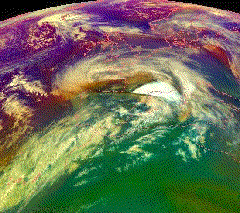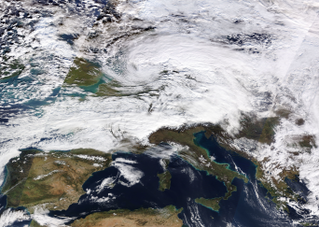
The Burns' Day Storm was an extremely violent windstorm that took place on 25–26 January 1990 over North-Western Europe. It is one of the strongest European windstorms on record and caused many fatalities in the UK and Europe. This storm has received different names, as there was no official list of such events in Europe at the time. Starting on Burns Day, the birthday of the Scottish poet Robert Burns, it caused widespread damage and hurricane-force winds over a wide area.

Cyclone Lothar is regarded as the worst European windstorm recorded during the 20th century. Crossing France, Belgium, Luxembourg and Germany between 25 December and 27 December 1999, Cyclone Lothar resulted in 110 fatalities and more than €15 billion in damage, becoming the costliest European windstorm ever recorded.
Cyclone Emma was an extratropical cyclone that passed through several mainly Central European countries, on Saturday March 1, 2008, killing at least twelve people in Austria, Germany, Poland and the Czech Republic. Wind speeds reached up to 155–180 km/h (96–112 mph) in Austria and the Czech Republic. Major infrastructure disruptions and some injuries were also reported in Belgium, France, Switzerland, and the Netherlands.

European windstorms are powerful extratropical cyclones which form as cyclonic windstorms associated with areas of low atmospheric pressure. They can occur throughout the year, but are most frequent between October and March, with peak intensity in the winter months. Deep areas of low pressure are common over the North Atlantic, and occasionally start as nor'easters off the New England coast. They frequently track across the North Atlantic Ocean towards the north of Scotland and into the Norwegian Sea, which generally minimizes the impact to inland areas; however, if the track is further south, it may cause adverse weather conditions across Central Europe, Northern Europe and especially Western Europe. The countries most commonly affected include the United Kingdom, Ireland, the Netherlands, Norway, Germany, the Faroe Islands and Iceland.

Joachim is the name given to a European windstorm which caused major damage in much of Western Europe between December 16–17, 2011. Winds gusting to 212 km/h (132 mph) were recorded on the summit of Puy de Dôme in France. Joachim explosively deepened under the influence of a shortwave trough during its development.

Cyclone Andrea was an intense European windstorm that affected western and central Europe in early January 2012.

Cyclone Niklas, also known as the Lentestorm in the Netherlands, was a European windstorm that affected areas of western and central Europe with widespread disruption to air, shipping and road transport at the end of March 2015.
The 2016–17 UK and Ireland windstorm season was the second instance of the United Kingdom's Met Office and Ireland's Met Éireann naming extratropical cyclones. Substantially less active than the previous season, the season succeeded the 2015–16 UK and Ireland windstorm season and preceded the 2017–18 European windstorm season.
The 2017–2018 European windstorm season was the third instance of seasonal European windstorm naming. France, Spain and Portugal took part in winter storm naming for the first time this season.

Cyclone Herwart was a European windstorm that affected Southern Denmark, Germany, Poland, Austria, Hungary and the Czech Republic on 28–29 October 2017. Named by the Free University of Berlin Meteorology Department, the storm was an extratropical cyclone formed as a secondary low to a more northerly centre of low pressure named Grischa coming southward from the Svalbard Islands region, the latter splitting in two low-pressure areas late on 28 October. The center of Herwart started rotating counterclockwise around the main low pressure area, passing over Norway, Sweden, Latvia and then losing power while moving over western Russia.

Storm Eleanor was an extratropical cyclone and European windstorm that affected Ireland, the United Kingdom, France, Benelux, Germany, Austria and Switzerland on the 2–3 January 2018. The storm caused extensive damage and traffic disruption. It was given the name Eleanor by Met Éireann and the UK Met Office, while the Free University of Berlin named the low pressure Burglind.

Cyclone Zeus was an extratropical cyclone and European windstorm which affected France on 6–7 March 2017. The storm developed rapidly and moved quickly across France on a north-west/south-east trajectory from Finistère in Brittany to the Alpes-Maritimes then Corsica. The storm's rapid strengthening resulted in much stronger winds than initially expected, with a maximum gust of 193 kilometres per hour (120 mph) recorded in Camaret-sur-Mer, Finistère.

Storm David was a compact but deadly European windstorm that heavily affected the British Isles, France, Benelux, Central Europe, Northern Italy, Poland and parts of Eastern Europe in early 2018 with widespread hurricane-force gusts and severe snowfall, creating blizzard conditions in some areas. The storm caused extensive damage and traffic disruption. It was given the name David by Météo France while the FUB named it Friederike.
The 2018–2019 European windstorm season was the fourth instance of seasonal European windstorm naming in Europe. Most storms form between September and March. The first named storm, Ali, affected primarily the United Kingdom and Ireland on 19 September 2018.

The 2019–20 European windstorm season was the fifth instance of seasonal European windstorm naming in Europe. This is the first season in which the Netherlands participates, joining Ireland's and the United Kingdom's meteorological agencies. The new season's storm names were released on 6 September 2019. In July 2019, it was announced that storm seasons would run from 1 September 2019 to 1 September 2020. The Portuguese, Spanish and French meteorological agencies again collaborated too, joined by the Belgian meteorological agency.

Storm Ciara was a powerful and long-lived extratropical cyclone that was the first of a pair of European windstorms to affect the United Kingdom and Ireland at peak intensity less than a week apart in early February 2020, followed by Storm Dennis a week later. Ciara caused widespread wind and flooding damage across Europe, and at least 13 fatalities.
The 2020–2021 European windstorm season was the sixth instance of seasonal European windstorm naming in Europe. This is the second season in which the Netherlands participates, joining Ireland's and the United Kingdom's meteorological agencies. The new season's storm names were released on 1 September 2020. Storms that occur up until 31 August 2021 will be included in this season. The Portuguese, Spanish, and French meteorological agencies will again collaborate too, joined by the Belgian meteorological agency.

The 2021–22 European windstorm season was the seventh instance of seasonal European windstorm naming in Europe. This was the third season in which the Netherlands participated, alongside the meteorological agencies of Ireland and the United Kingdom. The season's storm names were released on 1 September 2021. Storms that occurred up until 31 August 2022 were included in this season. The Portuguese, Spanish, French and Belgian meteorological agencies collaborated again, for the fifth time, joined by the Luxembourg meteorological agency. This was the first season when Greece, Israel and Cyprus, and Italy, Slovenia, Croatia, Montenegro, North Macedonia and Malta named storms which affected their areas.

The 2022–23 European windstorm season is the deadliest and costliest European windstorm season on record, mainly because of Storm Daniel, which became the deadliest and costliest medicane ever recorded as well as the deadliest tropical or subtropical system worldwide since 2008.
















